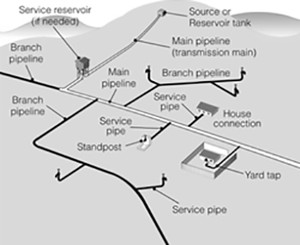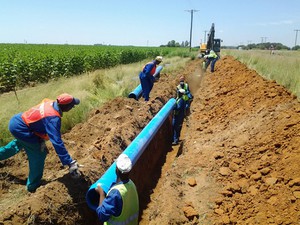Water delivery in urban settings
Water in urban areas is usually conveyed through a network of pipes to reach the users. Figure 7.1 is a diagram of a typical distribution and delivery system.

Figure 7.1 Schematic of a water distribution and delivery system.
Compare Figure 7.1 with Figure 1.10 in Study Session 1. Which parts of the system can you see in both diagrams?
The transmission main and service reservoir are in both diagrams. The treatment works in Figure 1.10 is equivalent to the ‘Source’ here. The distribution mains are shown in Figure 7.1 as the main and branch pipelines.
Figure 7.1 also shows the further distribution options labelled as ‘house connection’ (indoor taps), ‘yard tap’ (outside the house) and ‘standpost’. Standposts or standpipes are equivalent to public taps and water points. Water can also be obtained from kiosks, which are booths selling, in addition to water, food, household items, etc. The junctions in the system, where one pipe connects to another, should be controlled by valves so that water flow can be managed in the separate sections and different parts can be isolated. This allows repairs to be made to one section without cutting off the supply elsewhere.
In some cases, in order to reach the extremities of the distribution system the water may have to be pressurised and pumped. Pressurising the water also prevents entry of contaminants should there be a crack in the pipe.
In flat areas of the country, certain structures are used to ensure the water can flow by gravity to users. What are these structures?
Water towers.
The pipework of a distribution system can be made of different materials. In the old days pipes were often made of metal, but nowadays it is very common to see polyethylene or other types of plastic pipes. Plastic pipes can last in excess of 100 years (Plastics Industry Pipe Association, n.d.) and do not suffer from corrosion as metal pipes do. Corrosion is the gradual destruction of materials (usually metals) by chemical reaction with their environment. Corrosion in pipes leads to a reduction in their water-carrying capacity, so that the water requires greater pumping (thus consuming more energy). In addition, when metal pipes corrode they release metals into the water, causing undesirable aesthetic and health effects. When unlined iron pipes are used, iron can be released and this causes the water to appear brown or red. Washing light-coloured clothes with this water leaves a stain. Plastic pipes are lighter and therefore easier to transport, and they are also easier to lay (Figure 7.2).

Figure 7.2 Plastic water mains being laid.